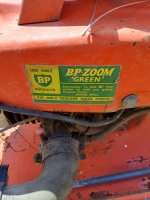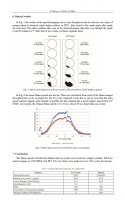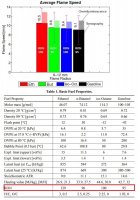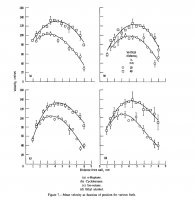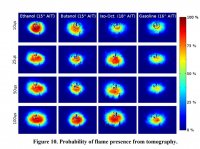https://www.sunocoracefuels.com/tech-article/beyond-octane
The discrepancies we are having in the discussion are that the generalities are correct, but as usual exceptions do apply.
In
general, lower octane fuels burn faster because they have smaller hydrocarbon chains. Any fuel will burn at a certain heat level because the energy will cause the molecular bonds to break and oxidize. We compress fuel/air mix to add heat and get it to the point where the molecule becomes unstable. Then, the spark adds the last bit of energy needed to make the reaction get past the point where the reaction occurs.
But we also get into densities of hydrocarbons, specific properties, weights, etc...
There will always be exceptions to the rule, but in general a fuel rated at a resistance to detonation similar to Octane (100%=100 octane rating) will have a slower burn rate. The slower burn rate may result in more power (from more controlled and homogenous combustion) or less power.
Interesting tidbit from Wikipedia. We need to consider that the evaporation/atomization of the fuel into the air causes an endothermic reaction which cools the engine and charge. The lower the octane fuel, the cooler the engine should be. The charge causes a significant cooling on a chainsaw engine. This may be part of what lower octane fuels help chainsaw engine’s performance.
“Higher octane ratings correlate to higher
activation energies: the amount of applied energy required to initiate combustion. Since higher octane fuels have higher activation energy requirements, it is less likely that a given compression will cause uncontrolled ignition, otherwise known as autoignition or detonation.
Because octane is a measured and/or calculated rating of the fuel's ability to resist autoignition, the higher the octane of the fuel, the harder that fuel is to ignite and the more heat is required to ignite it. The result is that a hotter ignition spark is required for ignition. Creating a hotter spark requires more energy from the ignition system, which in turn increases the parasitic electrical load on the engine. The spark also must begin earlier in order to generate sufficient heat at the proper time for precise ignition. As octane, ignition spark energy, and the need for precise timing increase, the engine becomes more difficult to "tune" and keep "in tune". The resulting sub-optimal spark energy and timing can cause major engine problems, from a simple "miss" to uncontrolled detonation and catastrophic engine failure.
The other rarely-discussed reality with high-octane fuels associated with "high performance" is that as octane increases, the
specific gravity and energy content of the fuel per unit of weight are reduced. The net result is that to make a given amount of
power, more high-octane fuel must be burned in the engine. Lighter and "thinner" fuel also has a lower
specific heat, so the practice of running an engine "rich" to use excess fuel to aid in cooling requires richer and richer mixtures as octane increases.
Higher-octane, lower-energy-dense "thinner" fuels often contain
alcohol compounds incompatible with the stock fuel system components, which also makes them
hygroscopic. They also evaporate away much more easily than heavier, lower-octane fuel which leads to more accumulated contaminants in the fuel system. Its typically the hydrochloric acids that form due to that water[
citation needed] and the compounds in the fuel that have the most detrimental effects on the engine fuel system components, as such acids corrode many metals used in gasoline fuel systems.
During the compression stroke of an internal combustion engine, the temperature of the air-fuel mix rises as it is compressed, in accordance with the
ideal gas law. Higher compression ratios necessarily add parasitic load to the engine, and are only necessary if the engine is being specifically designed to run on high-octane fuel. Aircraft engines run at relatively low speeds and are "
undersquare". They run best on lower-octane, slower-burning fuels that require less heat and a lower compression ratio for optimum vaporization and uniform fuel-air mixing, with the ignition spark coming as late as possible in order to extend the production of cylinder pressure and torque as far down the power stroke as possible. The main reason for using high-octane fuel in air-cooled engines is that it is more easily vaporized in a cold carburetor and engine and absorbs less intake air heat which greatly reduces the tendency for
carburetor icing to occur.
With their reduced densities and weight per volume of fuel, the other obvious benefit is that an aircraft with any given volume of fuel in the tanks is automatically lighter. And since many airplanes are flown only occasionally and may sit unused for weeks or months, the lighter fuels tend to evaporate away and leave behind fewer deposits such as "varnish"[
clarification needed]. Aircraft also typically have dual "redundant" ignition systems which are nearly impossible to tune and time to produce identical ignition timing so using a lighter fuel that's less prone to autoignition is a wise "insurance policy". For the same reasons, those lighter fuels which are better solvents are much less likely to cause any "varnish" or other fouling on the "backup" spark plugs.[
citation needed]
Because of the high cost of unleaded, high-octane
avgas, and possible increased range before refueling, some general aviation pilots attempt to save money by tuning their fuel-air mixtures and ignition timing to run "lean of peak"[
clarification needed]. Additionally, the decreased air density at higher altitudes (such as Colorado) and temperatures (as in summer) requires leaning (reduction in amount of fuel per volume or mass of air) for the most power (crucial for takeoff). In almost all general aviation piston engines, the fuel mixture is directly controlled by the pilot, via a knob and cable or lever similar to (and next to) the
throttle control. Leaning must be done carefully, as some combinations of fuel mixture and throttle position (that produce the highest
EGT) can cause detonation and/or pre-ignition, in the worst case destroying the engine within seconds.[
citation needed] Pilots are taught in primary training to avoid settings that produce the highest exhaust gas temperatures, and run the engine either "rich of peak" (more fuel than can be burned with the available air) or "lean of peak" (less fuel, leaving some oxygen in the exhaust) as either will keep the fuel-air mixture from detonating prematurely.[
citation needed]”
Oil Thread 2.0







